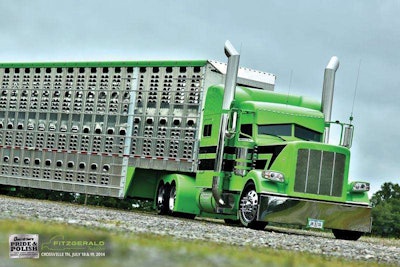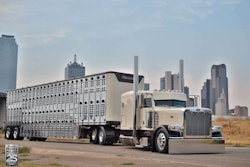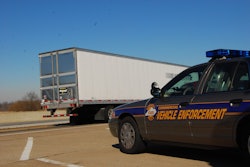 Drivers carrying loads of livestock or agriculture commodities, defined in the story below, have an extra 90 days to adopt an electronic logging device.
Drivers carrying loads of livestock or agriculture commodities, defined in the story below, have an extra 90 days to adopt an electronic logging device.Just shy of a month after announcing it would give drivers hauling livestock and other agricultural commodities a brief reprieve from compliance with the electronic logging device mandate, the U.S. DOT has officially released the waiver granting such haulers until March 18, 2018, to switch from paper logs to ELDs. The document is available on the DOT’s website but has not yet been officially published in the Federal Register.
The compliance extension gives drivers covered by the waiver an extra 90 days beyond the standard December 18 ELD mandate compliance deadline. The DOT’s Federal Motor Carrier Safety Administration says the delay for ag and livestock haulers will also give the agency time to consider other ELD-related exemptions requested by drivers who work in the ag industry, the agency says.
The waiver does not change the hours of service regs that livestock and ag haulers operate under. Drivers covered by the waiver include those hauling “any agricultural commodity, non-processed food, feed, fiber, or livestock.” Livestock is defined as “…cattle, elk, reindeer, bison, horses, deer, sheep, goats, swine, poultry (including egg-producing poultry), fish used for food and other animals designated…that are part of a foundation herd or offspring.” The waivers apply to all drivers hauling the aforementioned loads, regardless of their distance traveled or whether they cross state lines.
“Agricultural commodity” is defined in the waiver broadly with reference to the description in portions of the existing ag short-haul exemption to the hours of service. For the purposes of the ELD waiver, however, FMCSA is explicit in granting it to ag haulers “regardless of the distance traveled.” Those exempt from ELDs include truckers hauling “agricultural commodities from the source” to any location.
Drivers operating under the compliance extension must have a copy of the waiver with them, available at this link. The agency’s decision to grant the compliance extension stems from multiple requests from trade groups representing the ag and livestock businesses, who said the ELD mandate “exposed incompatibilities between the HOS rules and the” ag hauling industry. The National Pork Producers Council, for instance, said the strict adherence to hours of service rules prompted by the ELD mandate would “[endanger] the health and welfare of animals transported.”
Carriers operating under the 90-day waiver must notify the agency within five business days if they are involved in a crash and relay details of the crash and their driving day to the agency.
The waiver for livestock haulers is likely to be published in the coming days in the Federal Register, which would legally codify the waiver. Also slated for publication in the coming days is a proposal by FMCSA to expand and clarify the hours of service exemptions granted to truckers hauling ag products.
Drivers operating in the ag industry already have an hours of service exemption that clears them from maintaining records of duty status if they drive within a 150-air-mile radius of the source of their ag products or livestock.
The agency’s new proposal would expand that to include ag haulers operating unladen vehicles within a 150-mile radius of the load’s source point and after its delivery, meaning the exemption would apply to ag haulers operating an unloaded vehicle on their way to pick up a load and after they’ve delivered their load, in addition to while they are loaded and in transit. FMCSA defines this change as applying to “a driver operating an unladen commercial motor vehicle … either to a source to pick up an agricultural commodity or on a return trip following delivery of an agricultural load.”
The agency is also accepting comments from industry stakeholders for 30 days — after the date of its publication — regarding whether livestock sale barns and grain elevators should be considered a source of agricultural commodities. “While these facilities are originating points for many agricultural commodity loads, they are not expressly encompassed within the statutory or regulatory terminology of the [short-haul ag] exception,” says FMCSA.
FMCSA is also accepting feedback on whether ag haulers who pick up partial loads at more than one location should have the 150-mile radius extended from their final pick up, rather than their load’s origin. “Previous informal guidance has been that the air-mile radius is based on the first source….and that additional stops to load additional agricultural commodities do not extend the 150-mile radius,” the agency notes.
Lastly, the agency clarifies that the 150-air-mile radius covers drivers from the source of their load up to 150 air miles away, regardless of whether their destination is beyond 150 miles from their load’s source. After a driver crosses the 150-mile mark, however, they are then subject to record-keeping requirements and hours of service regs.
Overdrive will publish a link to the formal comment portal once FMCSA has published the documents.
The current air-mile radius exemption, passed by Congress in the MAP-21 highway funding act, was meant mostly as a reprieve for those who aren’t drivers by trade, such as farmers transporting their crops to other destinations. But it can apply to truckers who service farms and other agricultural producers, too.











